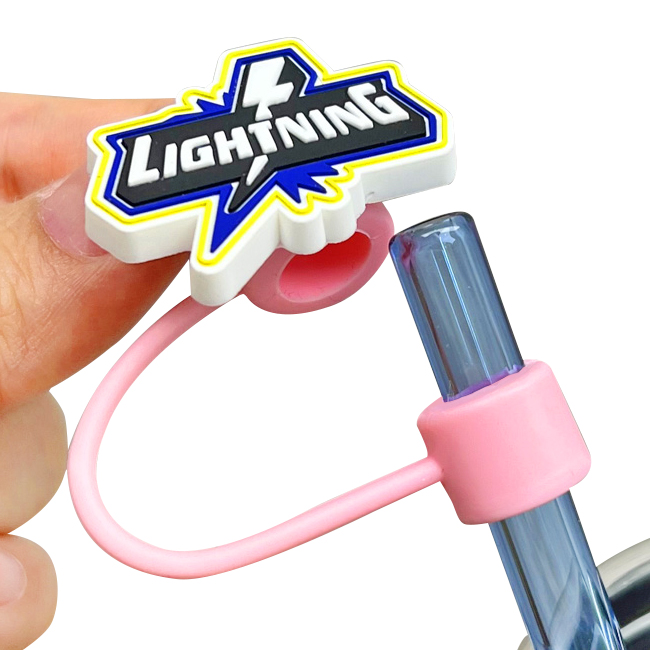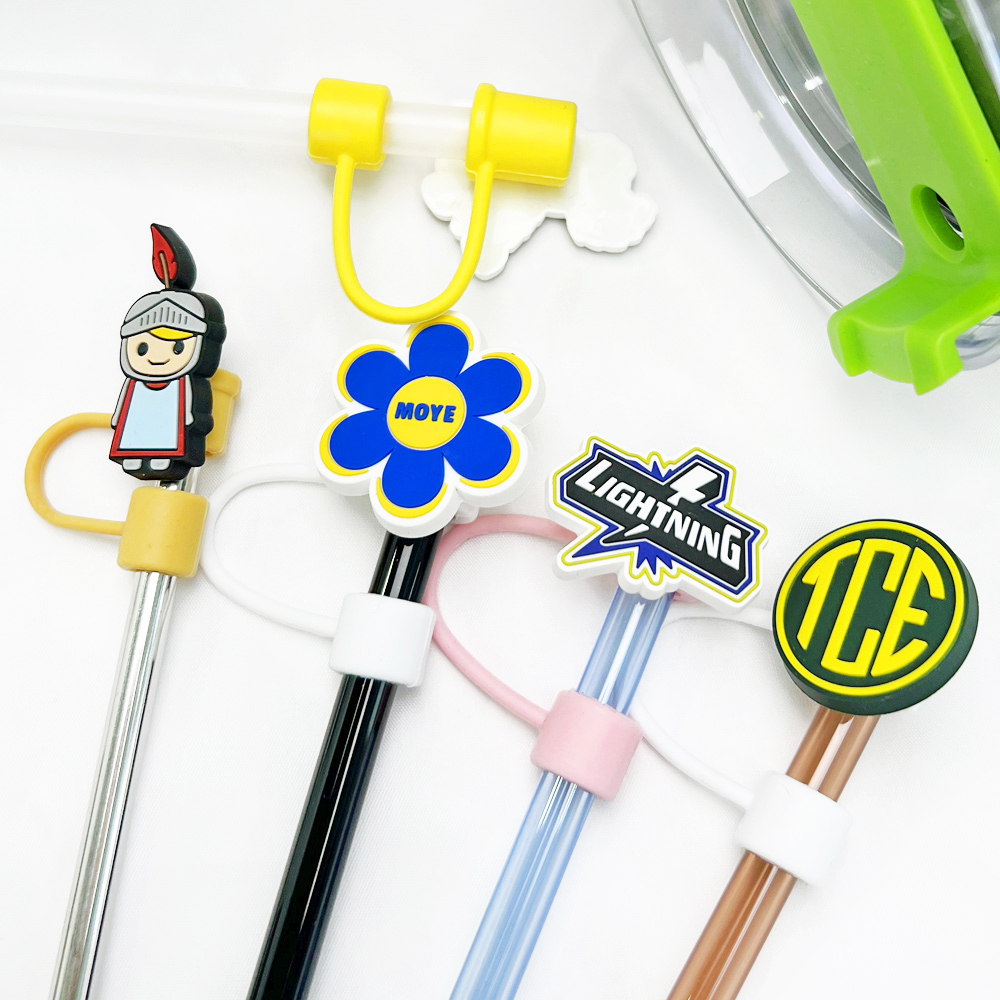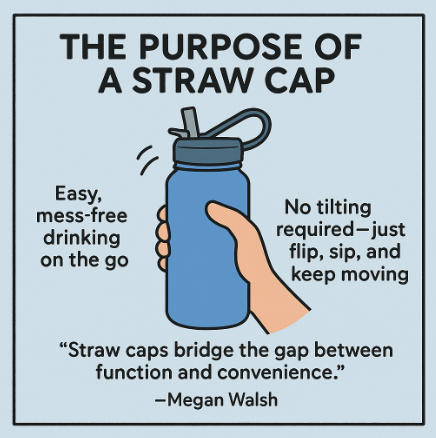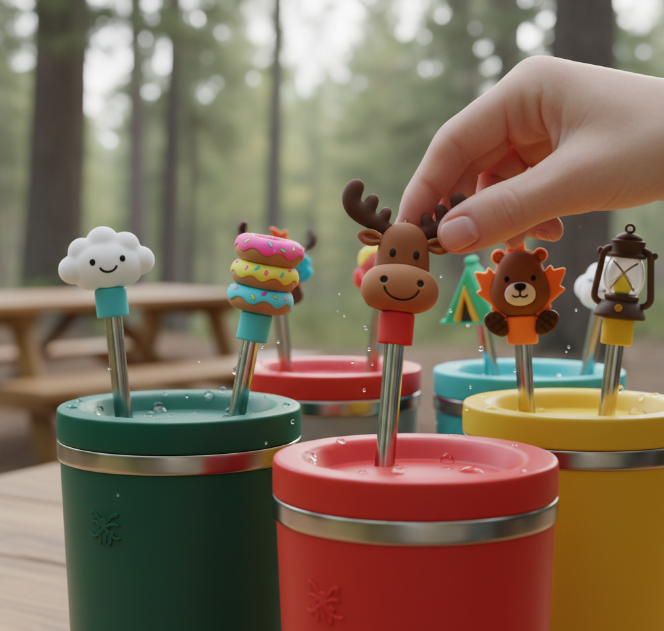
Table of Contents
Part 1 - What is a straw cap and how does it work?
Part 2 - Straw cap vs standard lid: What's the difference?
Part 3 - Leakproof design features
Part 4 - Insulated vs non-insulated straw caps: What matters?
Part 5 - Bottle brand compatibility
Part 6 - Is a flip straw cap better for on-the-go use?
What is the purpose of a straw cap? In short: easy, mess-free drinking on the go. No twisting, no tilting—just flip, sip, and keep moving. They’re built for real life, from rush hour commutes to post-workout gulps.
Think of it like cruise control for your hydration—hands-free, hassle-free. As outdoor gear expert Megan Walsh puts it, “Straw caps bridge the gap between function and convenience. You don’t realize how useful they are until you’ve used one.”
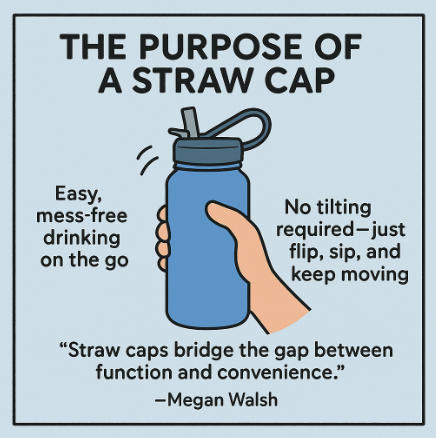
We’ll break down how straw caps work, how they stack up to regular lids, and which style fits your bottle—and your daily routine.
“When we redesigned our travel bottles, the straw cap changed everything,” says Maya Grant, lead designer at NorthPeak Gear. “Customers wanted ease, hygiene, and no leaks. We listened.” The straw cap has since become a game-changer in drinkware—particularly for those who value clean sipping and everyday portability.
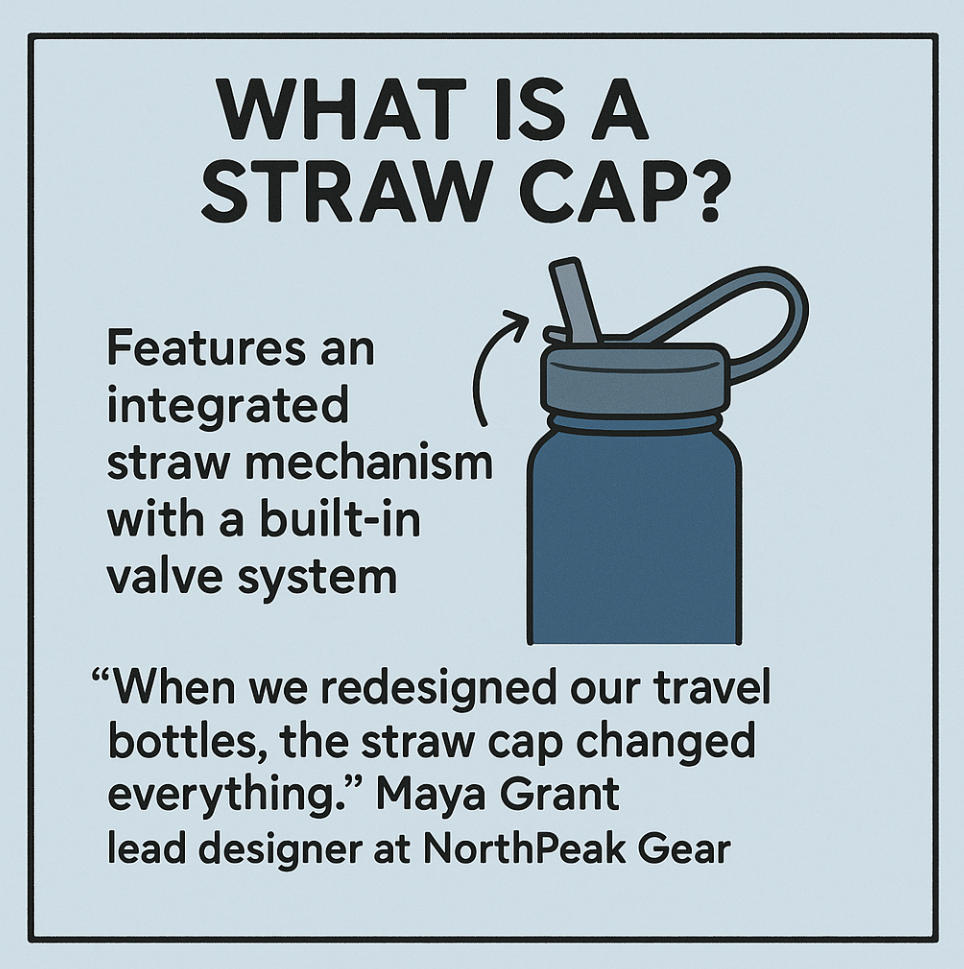
Unlike standard twist-off lids, a straw cap features an integrated straw mechanism with a built-in valve system that allows liquid to flow only when in use. This improves hygiene by minimizing contact with open surfaces and reduces the chance of spills. It functions through pressure: you sip, the seal releases briefly, then re-locks to stop any backflow or dripping. Think of it as a leak-fighting drinking companion designed for both workouts and morning commutes.
✔ Key benefits users have noted:
Hands-free sipping while driving or cycling
Enhanced leak prevention via tight seal engineering
Better drink flow control for smoothies, water, and iced coffee
According to a 2024 GearLab review, bottles equipped with certified straw caps scored 34% higher in user satisfaction—citing convenience and spill resistance. Top-rated models like the Yeti Rambler and Hydro Flask Flex Straw Cap come with BPA-free parts, cleaning guides, and leak-proof guarantees.
Some are even NSF-certified, reinforcing trust for health-conscious users.
“People do not want to second-guess their bottle,” says hydration expert Dr. Lena Raymond. “A quality straw cap gives them that confidence.”
Trying to decide between a straw cap and a regular lid? Here’s a quick breakdown of how they stack up in real life—whether you're hiking, commuting, or just trying to stay hydrated.
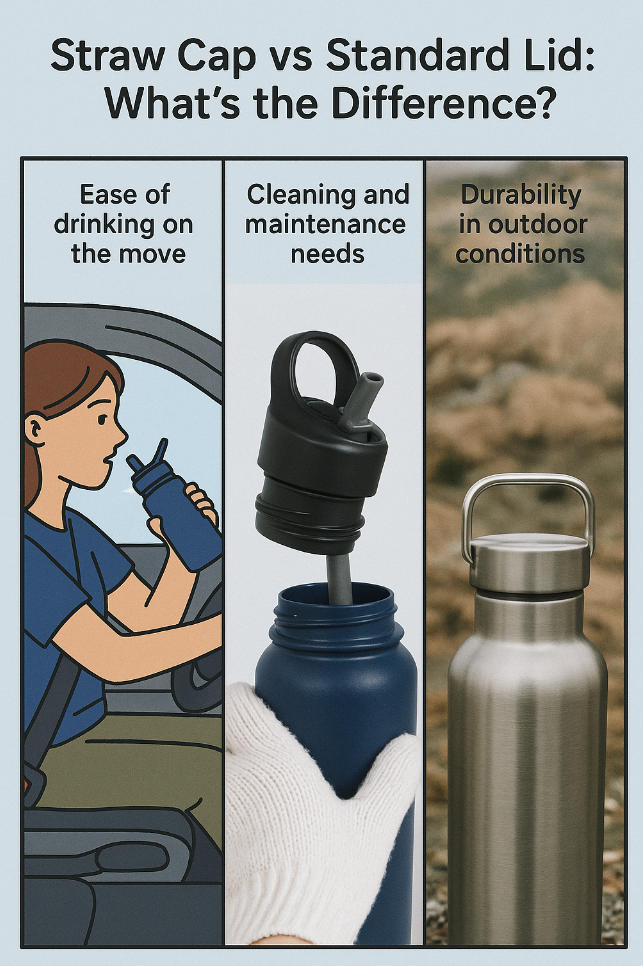
If you've ever juggled a hot thermos and your steering wheel, you know how clutch a straw cap is. It’s like turning your water bottle into a sippy cup for grownups—hands-free, no spills, no hassle.
Perfect for commuters, gym-goers, or cyclists.
Reusable straw + flip mechanism = ultimate convenience.
Think of it like a travel mug on autopilot: flip, sip, done.
“Straw caps are a game-changer for on-the-go hydration,” says Jenna Clarke, outdoor gear reviewer for DrinkSmart Magazine.
Straw caps often come with more moving parts, which means a bit more cleaning effort compared to standard screw-on lids. But don’t sweat it—it’s manageable.
Use gentle soap and a microfiber cloth for daily cleaning.
Deep clean the straw weekly using a pipe brush or straw cleaner.
Always follow brand care instructions to avoid mold or buildup.
🧽 Pro tip: Avoid soaking straw components too long—some materials warp with heat.
Let’s talk resilience. When you're out in the elements—sun, snow, or pouring rain—your lid better hold up.
| Material | UV Resistance | Rust-Proof | Outdoor Score (1–10) |
|---|---|---|---|
| Plastic Straw Cap | Medium | Low | 6 |
| Stainless Lid | High | High | 9 |
| Silicone Hybrid | Medium-High | Medium | 7.5 |
Weather-resistant designs make a huge difference.
Straw caps may need more protection from extreme temps and rough use.
Go fade-resistant or robust for rugged adventures.
Leakproof straw caps aren’t just marketing fluff—they're designed with features that make spills a thing of the past. Let’s break down what keeps your drink where it belongs.
Twist-lock systems rely on threaded closures to tightly secure the lid, but pressure seal designs use internal tension to form an airtight closure. While twist-locks feel more familiar (like closing a jar), pressure seals are often faster and more convenient—especially for one-handed use. Both have strong leak-proof potential, but pressure seals tend to wear less over time, reducing the risk of thread stripping or loosening caps.
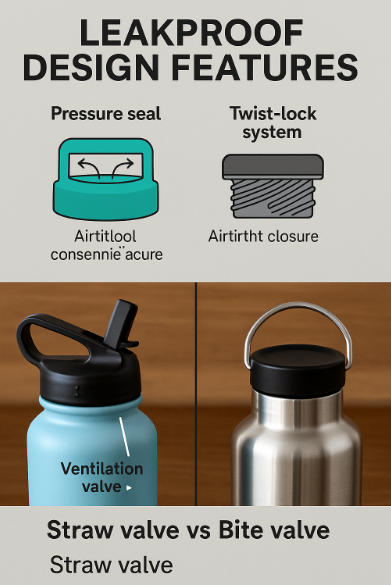
No one likes fighting with their water bottle just to get a sip. Good airflow control ensures smooth sipping without that annoying "glug-glug" or pressure buildup. Some straw caps come with built-in ventilation valves that manage the flow rate and improve overall drinking ergonomics. Bullet highlights:
Ventilation valves allow air to enter as you sip
Reduced suction effort improves comfort
Enhances hydration efficiency for sports and travel
Straw valves operate with passive flow—tilt and sip. Bite valves, however, require gentle biting to open the flow, offering precision hydration (common in CamelBak-style bottles). Here’s a quick comparison:
| Feature | Straw Valve | Bite Valve |
|---|---|---|
| Flow Control | Moderate | High |
| Hands-Free Use | No | Yes |
| Leak Resistance | Medium | High |
Hydration expert Rachel Lim says, “Bite valves give athletes total control. You don’t just sip—you command your flow.”
Let’s face it—leak points are the Achilles’ heel of straw caps. The usual suspects?
O-rings and gaskets – Dry or cracked seals can cause sneaky drips.
Valve connections – Loose-fitting valves often break the leak-proof promise.
Straw joints – Misaligned straws or broken seals at the base cause messy leaks.
Cap threads – Dirt buildup or worn threads lead to improper sealing.
Choosing between insulated and non-insulated straw caps isn’t just about keeping drinks cold—it’s about what fits your lifestyle, bottle, and daily routine.
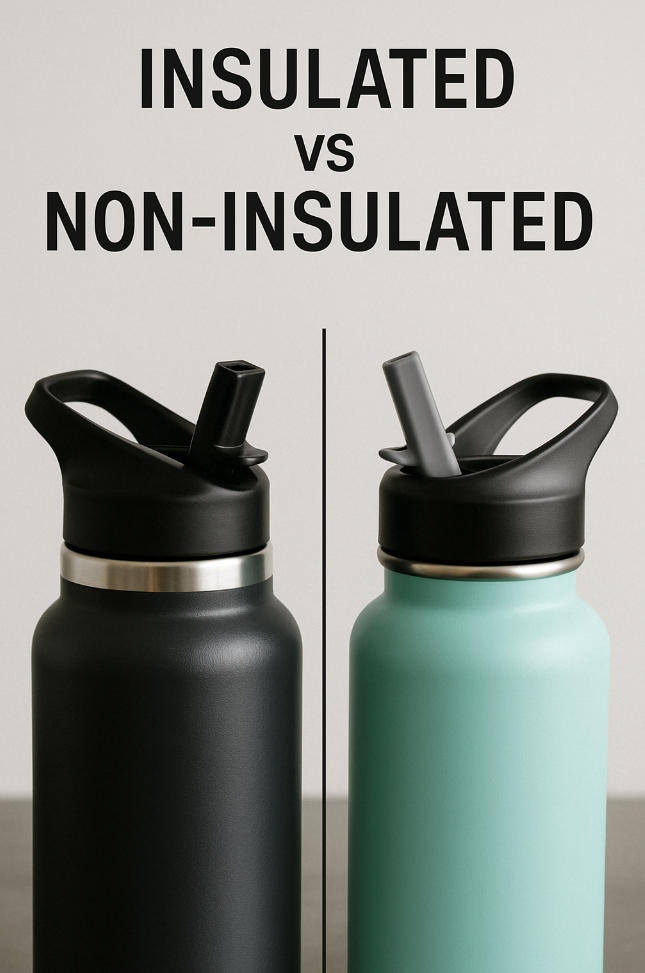
If you're counting on your cold brew staying cold till the end of a long shift, heat resistance and material thermal properties matter. Insulated straw caps—often made with stainless steel or double-walled plastic—help block metal heat transfer and preserve chill over time. These designs reduce moisture evaporation too, which prevents that “lukewarm regret” halfway through your day.
“Thermal consistency in portable drinkware has become a baseline expectation,” says Claire Donahue, product engineer at ColdCore. “Insulated caps are no longer a luxury—they’re essential.”
Let’s be real—insulated caps can add a bit of extra heft. But how much does that affect you?
Material density plays a major role: stainless steel is heavier, while high-grade plastic keeps things light.
Handling ease and portability can suffer slightly with bulkier designs, especially for hiking or gym bags.
Cleaning maneuverability is another trade-off—larger caps can be a pain to scrub, especially if you’re rushing out the door.
If you're constantly on the go, shaving off a few grams may be worth sacrificing insulation—depends if you're the "sip it slow" or "chug and go" type.
Not all straw caps are created equal—and not all bottles play nice with them. Here's how to match your lid with your favourite bottle brand.
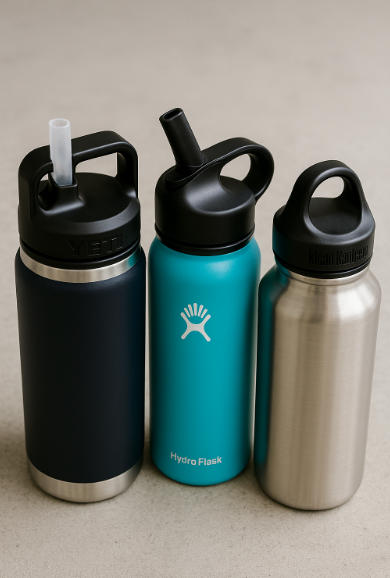
Yeti straw lids are tailor-made for their Rambler bottles, offering a snug, spill-proof fit. Designed to work with Yeti’s insulated drinkware, these caps are perfect for sipping cold drinks on the go. Look for genuine replacement caps and straw kits to ensure top performance. Bonus: many Yeti caps come with built-in handles for easy carry.
Hydro Flask has two main lid sizes: wide mouth and standard mouth. Their straw lids only fit wide mouth models, while sport caps are made for the standard ones. Want to swap? No dice—Hydro Flask lids are not interchangeable between sizes. Always check the cap type on your bottle before buying accessories.
Classic Cap – Fits most Klean Kanteen Classic bottles, great for everyday hydration.
Sport Cap – Designed for active use, with a quick-flow spout.
Loop Cap & Cafe Cap – Popular for commuters and hot drinks.
Kid Kanteen Caps – Smaller sizing, soft spouts—perfect for tiny hands.
Tip: Use the Klean Kanteen compatibility chart when choosing replacement lids.
Universal compatibility sounds good, but it's a gamble. Many “fits-all” caps don’t seal properly or impact insulation.
Brand-specific caps are designed with OEM specs, ensuring proper threading and leak resistance.
While third-party options exist, they may not offer a custom fit, especially for premium brands like Yeti or Hydro Flask.
You might save a few bucks, but aftermarket straw caps come with trade-offs:
Leaky seals and poor insulation are common.
Material quality can vary, affecting safety and durability.
Worst case? They could void your warranty.
“People are moving fast. Their water bottles should keep up,” says Erin Chouinard, a Canadian outdoor gear reviewer and hiking coach based in British Columbia. She recently tested over a dozen bottles on a five-day trail, and her go-to? A flip straw cap. “I need quick hydration, no spills, no fuss. Flip caps are a no-brainer for trail runs or transit.”
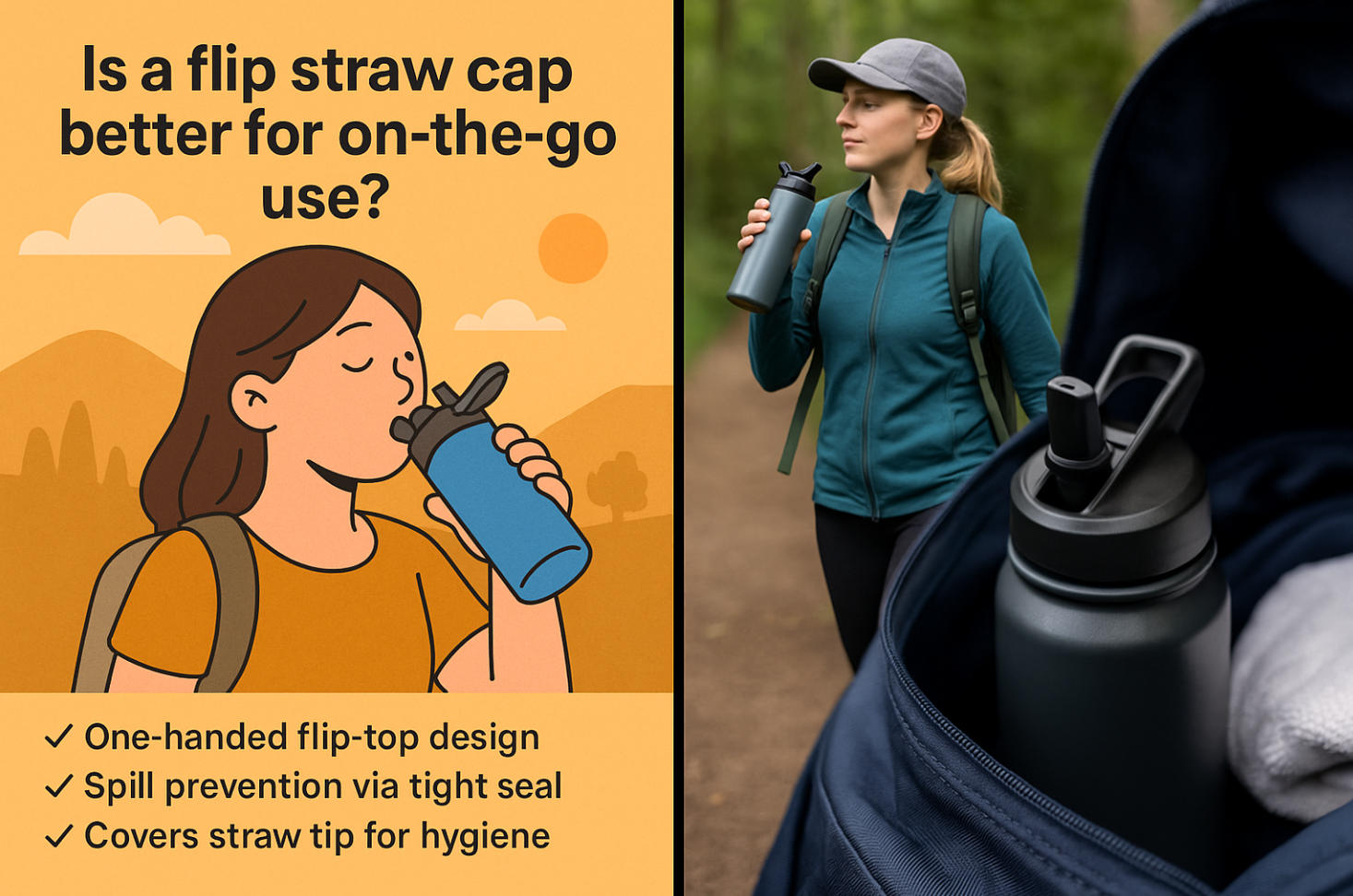
The flip straw cap is built for on-the-go use. Designed with portability and hygiene in mind, it allows for one-handed drinking while keeping the straw covered when closed. Commuters and travellers alike value its leak-proof seal—especially when tossing a bottle into a tote or gym bag.
Customer reviews from MEC and REI sites consistently praise its convenience during cycling, road trips, or running to catch a bus.
Key features for fast-paced users
One-handed flip-top design
Spill prevention via tight seal
Covers straw tip for hygiene
Built for durability, not just style
A recent survey by Outdoor Retailer Canada showed 68% of reusable bottle users choose flip straw caps for everyday portability. That preference is not surprising given the combination of hydration ease and compact, rugged form.
For everyday Canadian routines—from downtown Toronto to mountain towns in Alberta—this cap type proves it can handle the pressure.
Getting the right straw to match your bottle’s mouth size can make or break your sipping experience. Here’s how bottle openings and straw fit really work together.
Wide-mouth bottles (usually 2.2"–2.5") make life easier when it comes to cleaning, pouring, and adding ice. Narrow-mouth bottles (around 1.0"–1.5") offer better spill control and are easier to drink from without a straw.
| Bottle Type | Opening Size (inches) | Best For |
|---|---|---|
| Wide-mouth | 2.2 – 2.5 | Ice, smoothies, cleaning |
| Narrow-mouth | 1.0 – 1.5 | Controlled sips, travel |
| Mid-size hybrid | 1.75 – 2.0 | Daily hydration |
Design affects more than looks—your straw needs to fit the neck precisely to avoid leaking and awkward suction angles.
Some drinks just hit different when the straw's the right size. Too short? You're tilting like a flamingo. Too long? You’re slurping air and making bubble noises at the office. The length and thickness of a straw impact fluid dynamics, especially when you're sipping something thick like a protein shake. Longer straws need more sip pressure—think stronger suction—and narrower ones boost flow speed but clog easier.
Industry hydration coach L. Harper says: “People overlook straw ergonomics, but it’s often what ruins the drinking experience.”
Want that just right sip? Get into customization.
DIY tip: Cut silicone or plastic straws to match your bottle height—just be sure the diameter suits the lid.
If you're switching drinks often, consider reusable straws in different materials (stainless steel, silicone, BPA-free plastic) for both style and function.
Pro move: mark your straws by drink type—no one wants coffee aftertaste in their lemon water.
Personalized straws aren’t just about flair—they’re about making each sip feel like it was made for you.
Different drinks call for different gear. Choosing the right straw cap means smoother sipping—no clogs, no spills, no regrets.
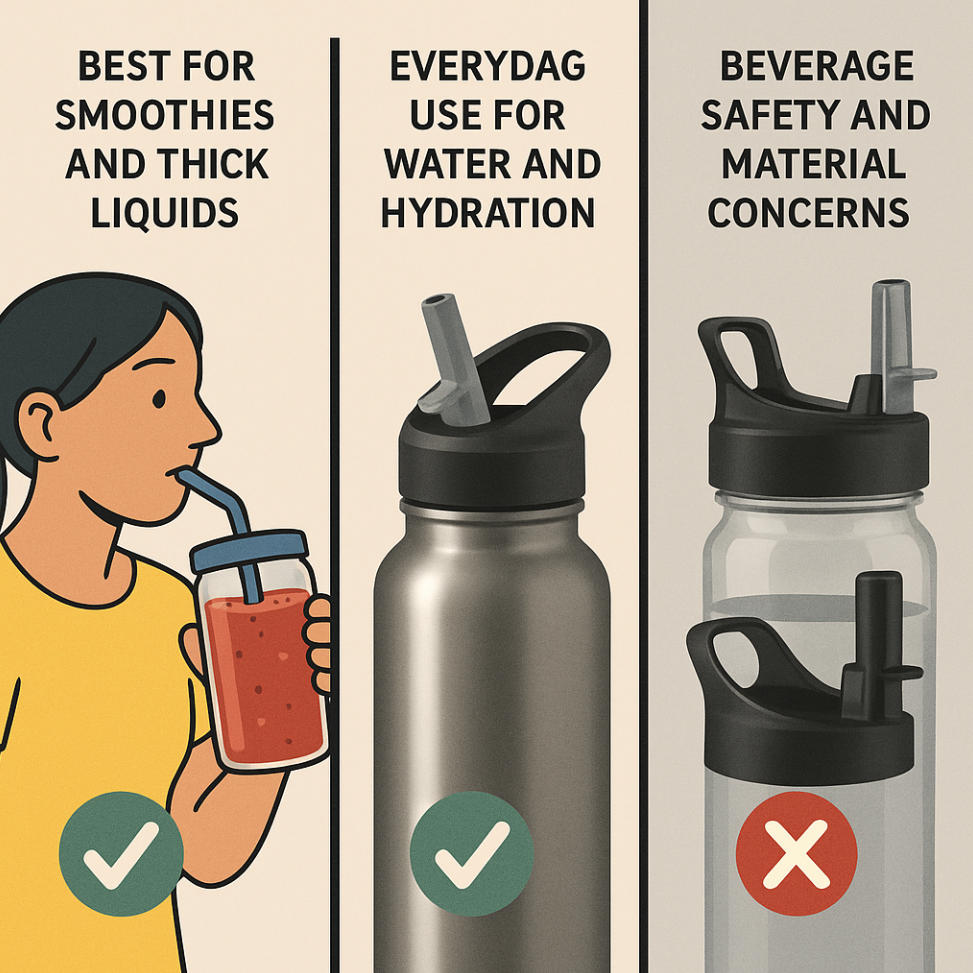
Ever tried sucking up a chunky fruit smoothie through a tiny straw? Yeah, not ideal. For blenders and thick beverages like protein shakes or milkshakes, go for straw caps with wide-bore silicone straws or removable extensions. They're built to handle ice, pulp, and heavy blends without turning every sip into a jaw workout.
“Thicker drinks need airflow and diameter—standard straw lids just won’t cut it,” says Lisa Menard, product tester at SmoothieTech.
Look for compatibility with portable travel blenders if you're blending on the go.
For those obsessed with cold brew or an iced latte, nothing beats a flip-top or sip lid designed for wide-mouth tumblers. Why?
They’re usually leak-proof, making them safe in backpacks.
Insulated caps keep your drink colder, longer.
Reusable straw caps reduce waste—and taste better than plastic café lids.
📌 Tip: Choose a straw lid with a soft silicone spout for a better sipping feel.
Standard straw caps with BPA-free plastics are ideal for water.
Great for gym sessions, school, or office use.
Pick a cap that matches your hydration goals—some come with built-in filters.
Wide or narrow mouth options help match your preferred flow rate.
Choose durable, eco-friendly materials that hold up to daily refills.
🧊 Want cold water all day? Pair your straw cap with a double-walled insulated bottle.
Here’s a quick look at what materials are safe—and which to avoid:
| Material | Safety Level | Notes |
|---|---|---|
| Stainless Steel | Excellent | Non-reactive and durable |
| BPA-Free Plastic | Good | Must meet food-grade standards |
| Silicone | Great | Flexible, easy to clean |
| Poor | May leach chemicals |
Always go for food-grade certified materials to avoid chemical leaching. Your health and hydration go hand-in-hand—don’t skimp on cap safety.
Let’s be real—no one enjoys juggling a bottle cap mid-walk or cleaning up a leaky mess in their bag. A good straw cap keeps things simple: flip, sip, and go. It’s like cruise control for hydration.
Hydration specialist Dr. Laura Chen puts it best: “Straw caps turn passive drinking into a seamless habit—especially for active lifestyles.”
Mostly, yes—but it depends on the design and brand. High-quality straw caps (like from Yeti or Hydro Flask) often use internal valves or locking mechanisms to prevent leaks. That said, tossing a bottle sideways in a bag without closing the straw properly? That’s a gamble.
Not always. Most straw caps are designed to fit specific bottle sizes or brands. If you're mixing and matching, always check:
Using the wrong cap might look like it fits—until it doesn’t.
Mouth size (wide vs narrow)
Brand-specific threads
Height of the bottle (for straw length)
Go for a cap that’s easy to open, bite-proof, and truly spill-resistant. Brands like CamelBak and Thermos have child-friendly designs, often with soft straws and one-button flip tops. Also: dishwasher-safe is your friend.
Not recommended. Most straw caps aren’t built for hot liquids—sipping hot coffee through a plastic straw? Ouch. Plus, the pressure from the heat could cause leaks or spills. Stick to cold or room-temperature drinks unless the cap says otherwise.
This part often gets skipped—but it shouldn't. To clean your straw cap thoroughly:
Some brands are top-rack dishwasher safe, but always double-check the label.
Remove the straw from the lid
Use a narrow straw brush for the inside
Rinse all pieces with warm, soapy water
Let them dry fully before reassembling
Yes! Some straw caps, especially from eco-conscious brands like Bink, use food-grade silicone. These are soft, flexible, and less likely to crack, making them a solid pick for casual daily use.
Not at all. The sipping experience can vary a lot depending on:
If sipping feels like a workout, it might not be the right cap for your drink.
Straw diameter
Venting mechanism (for airflow)
Valve type (bite or flip)
Drink thickness (water vs smoothie)
Look for wider straws—about 10mm or more. Klean Kanteen’s TKWide cap, for example, comes with a smoothie-friendly straw and extender. Bonus if it’s cut-to-fit.
Absolutely. Most major brands sell replacement straws separately. It's a small fix that can save your whole lid from the landfill.
